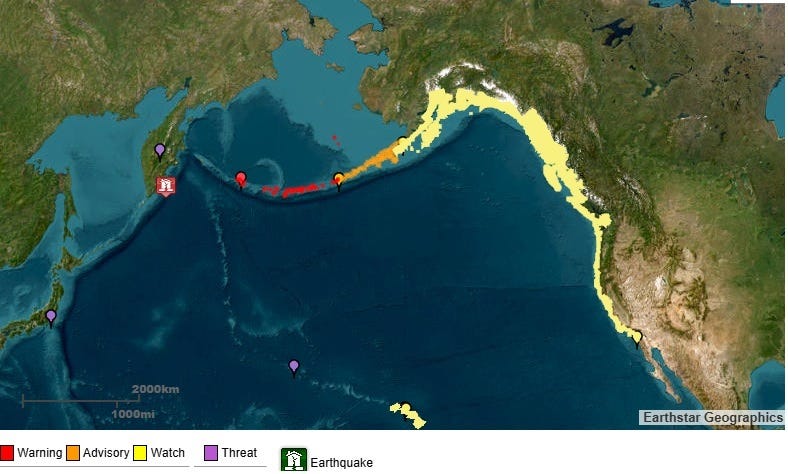Tsunami Warnings Issued for Alaska and West Coast After Major Russia Earthquake

Major Earthquake Strikes Kamchatka Peninsula, Triggering Widespread Tsunami Alerts
On July 29, a powerful earthquake measuring 8.8 on the Richter scale struck off the coast of Russia’s Kamchatka Peninsula, prompting widespread tsunami alerts across the United States and beyond. The U.S. Geological Survey (USGS) reported that the quake occurred at 7:24 p.m. ET, approximately 78 miles east-southeast of Petropavlovsk-Kamchatsky, Russia. The earthquake was shallow, occurring at a depth of about 12 miles, which contributed to its intensity.
Following the main event, multiple aftershocks were recorded, ranging in magnitude from 5.2 to 6.9. These secondary tremors added to the concern among emergency management officials and coastal communities.
Widespread Evacuation Warnings and Coastal Threats
Tsunami warnings were issued for Hawaii and along Alaska’s remote Aleutian Islands. Officials warned that the waves could cause damage along all coastal areas in Hawaii, urging residents to take urgent action to protect lives and property. The National Weather Service explained that tsunamis can create long series of waves that may flood coastal areas and pose dangers that persist for many hours after the initial waves arrive. All shores are at risk, regardless of their direction.
President Donald Trump took to social media to warn the public about the potential threat. He stated, “Due to a massive earthquake that occurred in the Pacific Ocean, a Tsunami Warning is in effect for those living in Hawaii. A Tsunami Watch is in effect for Alaska and the Pacific Coast of the United States. STAY STRONG AND STAY SAFE!”
Residents in the Aleutian Islands were advised to move away from water, beaches, harbors, marines, and inlets. The warning center emphasized that tsunamis can generate strong waves and currents, with waves potentially lasting up to 45 minutes as they encroach and recede.
Expanding Tsunami Watch Across the West Coast
A tsunami watch was also issued for the U.S. West Coast, including southern Alaska, British Columbia, Washington state, Oregon, and California, including Los Angeles Harbor. The watch extended inland along the Salish Sea in Washington to Port Angeles, Port Townsend, and Bellingham.
Reid Wolcott, a meteorologist with the weather service in Seattle, described the event as significant and real. He noted that while the immediate threat was for Alaska and areas near the earthquake, additional observation data would be needed before more information about the threat to the U.S. West Coast could be determined.
Impact on Hawaii and Alaska
In Hawaii, the Department of Emergency Management issued a tsunami warning, estimating that the first wave would arrive at 7:17 p.m. Hawaii Standard Time. The agency urged residents to take urgent action to protect themselves and their property. In Honolulu, some coastal areas were evacuated, with officials issuing urgent messages to stay safe.
The tsunami warning for Alaska included coastal areas from Attu to Samalga Pass, with an expanded advisory covering areas from Samalga Pass to Chignik Bay. Estimated tsunami start times varied by location, with specific times provided for several Alaskan cities.
Hazardous Currents Along the California Coast
In San Francisco and Monterey, the weather service expected tsunami heights of less than one foot but warned of strong and hazardous currents. Residents were advised to avoid beaches and harbors. In San Diego, similar advice was given, with a focus on avoiding the coast to prevent danger.
Dial Hoang, a meteorologist in San Francisco, reminded the public of the risks associated with tsunamis. He referenced a 2011 incident where a man near Crescent City was swept out to sea while photographing a tsunami.
Tsunami Alerts Extend to Japan and Pacific Islands
Japan's weather agency upgraded its warning, expecting tsunami waves of up to 10 feet to reach large coastal areas starting around 10:00 a.m. local time. Evacuation orders were issued in some regions. The U.S. Tsunami Warning System also issued warnings for parts of Russia, Japan, and Hawaii, with a watch in effect for Guam and other islands in Micronesia.
In Guam, the weather service warned of sea level fluctuations and strong ocean currents, advising people to avoid the ocean and move away from beaches and harbors. Similar advisories were issued for American Samoa, where hazardous sea level fluctuations and strong currents were expected.
Understanding Tsunami Alerts
The National Weather Service outlined four levels of tsunami alerts:
- Tsunami Warning: "Take Action—Danger! A tsunami that may cause widespread flooding is expected or occurring."
- Tsunami Advisory: "Take Action—A tsunami with potential for strong currents or waves dangerous to those in or very near the water is expected or occurring."
- Tsunami Watch: "Be Prepared—A distant earthquake has occurred. A tsunami is possible."
- Tsunami Information Statement: "Relax—An earthquake has occurred, but there is no threat or it was very far away."
How NOAA Tracks Tsunamis
The National Oceanic and Atmospheric Administration (NOAA) uses a real-time tsunami monitoring system called DART (Deep-ocean Assessment and Reporting of Tsunamis). These buoys are placed strategically in the ocean and play a critical role in forecasting tsunamis. When a tsunami occurs, the DART systems detect changes in sea level and send data to warning centers, which use this information to refine forecasts and issue alerts.
Despite its importance, the DART system faces potential budget cuts, raising concerns about the future of tsunami monitoring efforts.
Post a Comment for "Tsunami Warnings Issued for Alaska and West Coast After Major Russia Earthquake"
Post a Comment